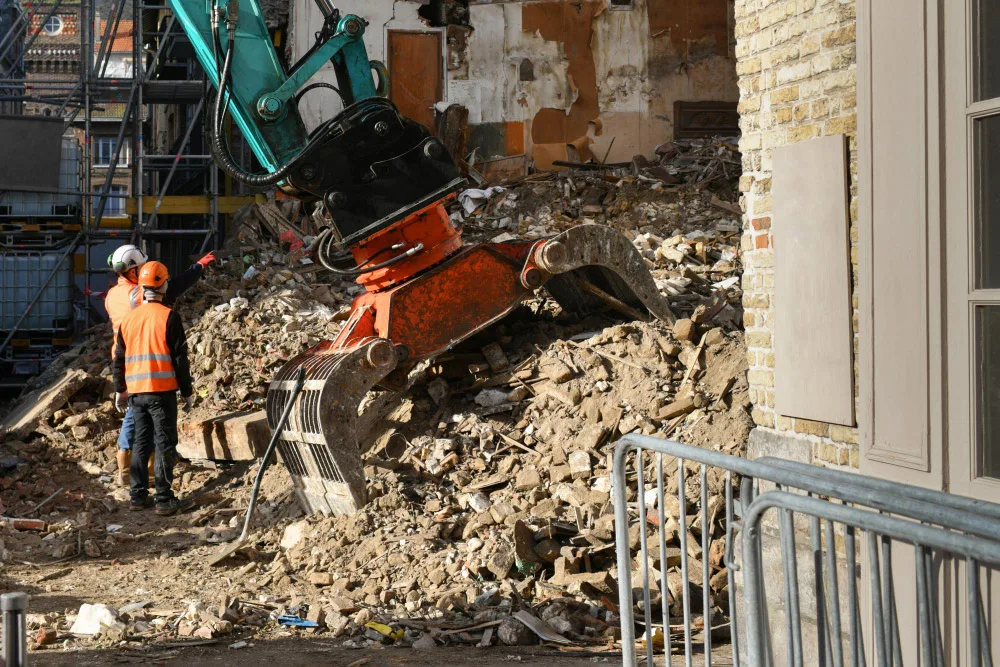Demolition comes with a lot of waste, known as demolition debris or C&D waste, Demolition waste management is a crucial aspect that requires careful planning and execution to ensure proper handling, disposal, and minimising environmental impact.
Many don’t know what happens to the waste after a demolition, so we will guide you through the various stages of demolition waste handling, from the initial sorting and segregation to the final destination.
Types of Waste Generated from Demolition
Demolition projects generate a diverse range of waste materials, including:
- Concrete: Concrete debris, such as slabs, foundations, and structural elements, often constitutes a significant portion of the waste stream.
- Bricks and Masonry: Bricks, blocks, and other masonry materials are commonly found in demolition debris.
- Wood: Lumber, plywood, and other wood products from framing, flooring, and other structural components.
- Metals: Steel beams, reinforcing bars, pipes, and other metal components.
- Drywall and Plasterboard: Interior wall materials, including drywall and plasterboard.
- Asphalt and Roofing Materials: Shingles, tar, and other roofing materials.
- Glass: Windows, mirrors, and other glass components.
- Plastics: Pipes, insulation, and various plastic materials.
- Hazardous Materials: Asbestos, lead-based paint, and other potentially hazardous materials that require special handling and disposal.
The Importance of Proper Debris Disposal
- Environmental Protection: Improper disposal of demolition waste can lead to soil, water, and air pollution, posing risks to human health and the environment.
- Resource Conservation: Recycling and repurposing demolition materials help conserve natural resources and reduce the demand for new raw materials.
- Compliance with Regulations: Demolition projects must comply with local, state, and federal regulations regarding waste management and disposal to avoid penalties and legal consequences.
- Cost Savings: Effective waste management practices, such as recycling and diversion from landfills, can lead to cost savings for demolition projects.
- Sustainability: Proper demolition waste management aligns with sustainability principles, promoting responsible resource use and minimising environmental impact.
Steps Involved in Demolition Waste Management
Sorting and Segregating Demolition Debris
Sorting and segregating demolition debris on-site is a crucial step in effective waste management. This process involves separating different materials into designated containers or areas for proper handling and disposal. Here are some common practices for sorting and segregating demolition debris:
- Material Categories: Separate materials into categories such as concrete, bricks, wood, metals, drywall, plastics, and hazardous materials.
- Dedicated Containers: Use clearly labelled containers or designated areas for each material category to facilitate proper sorting and segregation.
- Hazardous Materials Identification: Identify and segregate hazardous materials, such as asbestos or lead-based paint, for specialised handling and disposal.
- On-site Crushing and Compaction: Consider on-site crushing or compaction of materials like concrete or bricks to reduce transportation costs and increase efficiency.
- Training and Supervision: Provide training and supervision to demolition crews to ensure proper sorting and segregation practices are followed.
Recycling Construction and Demolition Waste
Recycling construction and demolition (C&D) waste is an essential component of responsible demolition waste management. By diverting materials from landfills, recycling helps conserve natural resources, reduce greenhouse gas emissions, and minimise environmental impact. Here are some common materials that can be recycled from demolition projects:
- Concrete: Concrete debris can be crushed and repurposed as aggregate for new construction projects, road-based material, or landscaping applications.
- Metals: Ferrous and non-ferrous metals, such as steel, aluminium, and copper, can be recycled and reused in various manufacturing processes.
- Wood: Clean, untreated wood can be recycled into mulch, animal bedding, or biomass fuel, while treated wood may be repurposed for non-structural applications.
- Drywall and Plasterboard: Gypsum-based materials can be recycled into new drywall or used as soil amendments in agriculture.
- Asphalt and Roofing Materials: Asphalt shingles and roofing materials can be recycled into new asphalt products or used as road base material.
Disposal of Hazardous Materials
Demolition projects often involve the removal and disposal of hazardous materials, such as asbestos, lead-based paint, and certain chemicals.
Here are some key considerations for hazardous material disposal:
- Identification and Assessment: Conduct a thorough assessment of the demolition site to identify potential hazardous materials before the project begins.
- Specialised Contractors: Hire qualified and licensed contractors with expertise in handling and disposing of hazardous materials.
- Containment and Handling: Implement proper containment, handling, and labelling procedures to prevent the release of hazardous materials during demolition and transportation.
- Disposal Facilities: Transport hazardous materials to licensed and approved disposal facilities that are equipped to handle and treat these materials safely.
- Documentation and Compliance: Maintain detailed records and documentation of hazardous material handling and disposal to ensure compliance with relevant regulations.
Landfill
While recycling and reuse are preferred options for demolition waste management, some materials may still end up in landfills. Landfills are engineered facilities designed to safely contain and isolate waste from the environment. Here are some key considerations for landfill disposal of demolition debris:
- Non-Recyclable Materials: Materials that cannot be recycled or repurposed, such as certain types of plastics, insulation, and contaminated materials, may be sent to landfills.
- Residual Waste: Even after recycling and diversion efforts, some residual waste may still require landfill disposal.
- Landfill Regulations: Landfills are subject to strict regulations and permitting requirements to ensure proper containment, monitoring, and management of waste.
- Leachate and Gas Management: Modern landfills employ systems to collect and treat leachate (liquid that passes through the waste) and manage methane gas generated by decomposing waste.
- Capping and Closure: Once a landfill reaches its capacity, it is capped with a protective cover and monitored for potential environmental impacts.
Repurposing and Donation
In addition to recycling, demolition debris can be repurposed or donated for various purposes, further reducing waste and promoting sustainability. Here are some options for repurposing and donating demolition materials:
- Building Material Reuse: Salvaged materials like doors, windows, fixtures, and architectural elements can be donated or sold for reuse in other construction projects or home renovations.
- Habitat for Humanity ReStores: Many Habitat for Humanity organisations operate ReStores that accept donations of gently used building materials, fixtures, and appliances for resale at discounted prices.
- Art and Creative Projects: Unique or interesting demolition materials can be repurposed for art installations, sculptures, or other creative projects.
- Landscaping and Gardening: Crushed concrete, bricks, and certain types of wood can be used for landscaping projects, pathways, or raised garden beds.
- Animal Shelters and Farms: Clean wood and other suitable materials can be donated to animal shelters for bedding or to farms for various agricultural purposes.
Documentation and Compliance
Proper documentation and compliance with relevant regulations are essential aspects of demolition waste management. Failure to comply with regulations can result in penalties, fines, and legal consequences. Here are some key considerations for documentation and compliance:
- Permitting and Approvals: Obtain necessary permits and approvals from local authorities before commencing demolition activities.
- Waste Management Plan: Develop a comprehensive waste management plan that outlines strategies for sorting, segregating, recycling, and disposing of demolition debris.
- Hazardous Materials Documentation: Maintain detailed records and documentation related to the identification, handling, and disposal of hazardous materials.
- Manifests and Tracking: Use waste manifests and tracking systems to document the transportation and disposal of demolition debris at licensed facilities.
- Regulatory Reporting: Comply with reporting requirements and provide documentation to regulatory authorities as required.
- Record Keeping: Maintain accurate records of waste quantities, disposal methods, and recycling efforts for future reference and auditing purposes.
Environmental Impact of Demolition Debris
- Pollution: Uncontrolled disposal of demolition waste can lead to soil, water, and air pollution, posing risks to human health and the environment.
- Resource Depletion: Failure to recycle and reuse demolition materials contributes to the depletion of natural resources and increased demand for new raw materials.
- Greenhouse Gas Emissions: Landfilling and improper waste management practices contribute to greenhouse gas emissions, exacerbating climate change.
- Habitat Destruction: Illegal dumping of demolition debris can destroy natural habitats and disrupt ecosystems.
- Visual Blight: Improper disposal of demolition waste can create unsightly and hazardous conditions in urban and rural areas.
Regulations and Compliance for Debris Disposal
Demolition waste management is subject to various regulations at the local, state, and federal levels. Compliance with these regulations is crucial to ensure proper handling, transportation, and disposal of demolition debris. Here are some key regulations and compliance considerations:
- Environmental Protection Agency (EPA) Regulations: The EPA establishes guidelines and regulations for the management of construction and demolition waste, including hazardous materials and air quality standards.
- State and Local Regulations: Many states and municipalities have specific regulations and permitting requirements for demolition activities and waste management.
- Hazardous Materials Handling: Strict regulations govern the identification, handling, transportation, and disposal of hazardous materials, such as asbestos and lead-based paint.
- Landfill and Disposal Facility Regulations: Landfills and disposal facilities must comply with stringent regulations regarding waste acceptance, containment, and environmental monitoring.
- Recycling and Diversion Requirements: Some jurisdictions have mandatory recycling or diversion requirements for construction and demolition waste, promoting recycling and reuse.
- Documentation and Reporting: Maintaining accurate records and documentation is essential for demonstrating compliance with regulations and reporting requirements.
In closing, the journey of demolition debris is a complex and multifaceted process that requires careful planning, execution, and adherence to regulations. From the initial sorting and segregation on-site to the final destination of recycling, repurposing, or disposal, each step plays a crucial role in minimising environmental impact and promoting sustainable practices.
By knowing the types of waste you’re dealing with and the best ways to handle it, you can make smart choices that turn demolition into a greener process. Let’s make tearing things down a bit more sustainable!



